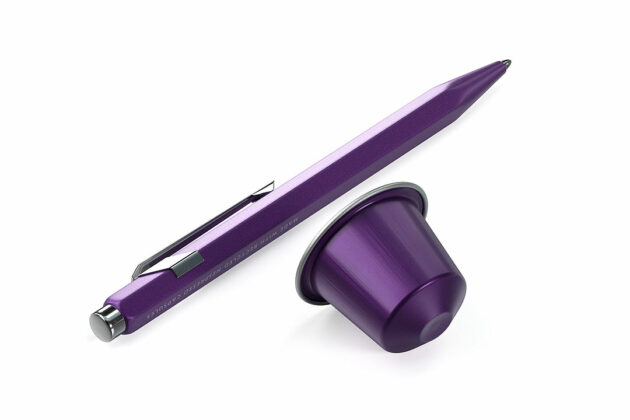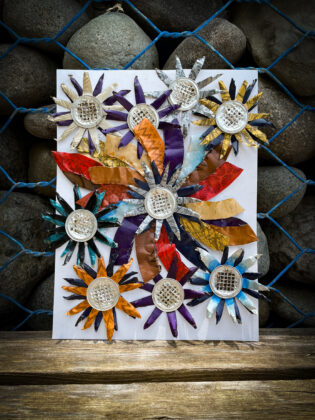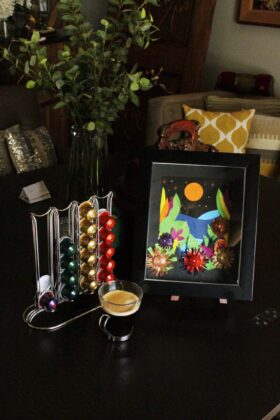Nespresso cleans up after itself
Makes recycling the name of the game
COFFEE makes the world go ’round, apparently, but coffee pods litter the earth, making for an imbalanced trade-off.
On Earth Day (April 22), Nespresso presented its sustainability commitments at Robinsons Magnolia, showing off a booth that displayed artwork made from ex-Nespresso coffee pods, as well as more practical applications.
In a partnership with Nespresso, young emerging artists from For the Future PH were commissioned to create original artworks that integrate materials including aluminum and coffee grounds from used Nespresso capsules. All proceeds are in support of the organization’s ongoing reforestation efforts with the Yangil Tribe in Zambales, one of the areas affected by the eruption of Mt. Pinatubo in 1991. Another partnership was formed with the Artisans of Hope project of the Negrense Volunteers for Change Foundation (NVC) which provides livelihood to vulnerable individuals and feeds undernourished children. Volunteers train people with limited income opportunities to create art from discarded materials like eggshells, leftover tiles, and Nespresso capsules. Much of the pods’ shredded aluminum is upcycled into mosaic-style decorative art. All proceeds from the artworks sold are used to support NVC’s feeding program for children in need.
Most of these efforts may seem small in scale, but Millet Valdez, Head of Commercial and Marketing for Nespresso distributor in the Philippines, Novateur Coffee Concepts, Inc., pointed to a great big aluminum ingot, about the size of three adult arms, in the booth. This ingot was made with the aluminum pods of Nespresso capsules, smelted by the Katipunan Metal Corp., and delivered for use to become car parts and cookware, among other applications. “We deliver tons and tons,” said Ms. Valdez, and the majority of the ex-pods go to industrial applications like these.
Customers are encouraged to deliver their used coffee pods to Nespresso stores (in Rockwell, Podium, and Robinsons Magnolia). These are also collected during e-commerce transactions. Customers are given incentives to do this: for example, getting a gift after giving away three bags of used capsules. “Just to make it more exciting, and just to keep it top of mind,” said Ms. Valdez of the incentives.
The remaining grounds are then separated from the capsules and then used as organic compost. “It makes the soil quality better,” said Ms. Valdez, since coffee grounds are rich in nitrogen, potassium, and phosphorus. The grounds are sent to local organic farms like Nutriganics Farm in Cavite, Saret Organic Farmville in Bulacan, and Palaya Farm in Rizal.
Ms. Valdez pointed to items made with ex-coffee pods in industrial applications: a Victorinox Swiss Knife, and a pen from Caran d’Ache, proving Switzerland-based Nespresso makes sustainability a global effort.
According to her, in markets closer to Nespresso manufacturers, the coffee pods are remade into coffee pods anew. “We are really required to have a recycling program in place to operate. It’s really part of their DNA,” said Ms. Valdez, speaking about the Philippine operations, despite not being directly managed by Nespresso in Switzerland.
The secret is in the material: “Aluminum is completely and infinitely recyclable,” she said.
Almost all Nespresso coffee capsules are made from 80% infinitely recyclable aluminum, which requires less energy to produce than raw materials. “The reason why they use aluminum for their capsules in the first place — apart from it being a material that protects the coffee effectively — is the fact that it’s recyclable — unlike plastic.” Nespresso has been using new packaging for its machines since March 2020, which makes use of 95% recycled material.
To guarantee overall proper waste management of Nespresso in the country, the company has partnered with Geocycle Philippines and Envirocycle. The former is part of the global waste management business of LafargeHolcim Group, which envisions a zero-waste future by actively developing and promoting innovative, customized, and safe environmental waste management solutions. Meanwhile, the latter is a full-service e-waste recycling company that aims to prevent the disposal of potentially polluting electronic equipment into landfills. Instead, these are to be reused or recycled through fully licensed and accredited channels. These would include corporate waste like paper and electronics.
“The goal is to really be 100% sustainable,” said Ms. Valdez. “It should span not just our products, but also our internal processes as an organization.” — J.L. Garcia







